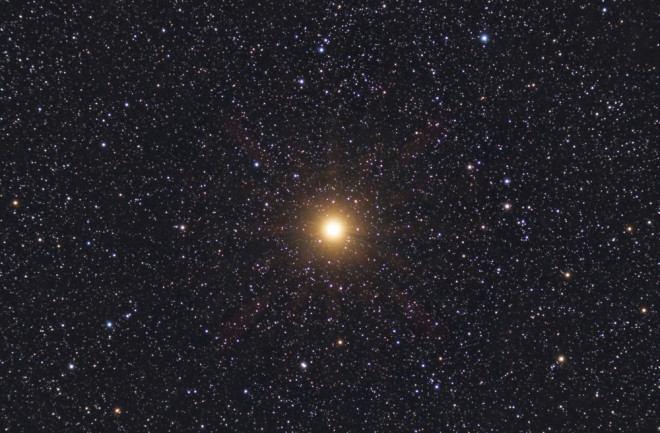The well-known star, Betelgeuse, has been exhibiting peculiar behavior in recent years, leading astronomers to believe that it is approaching its end.
Located in the constellation of Orion, Betelgeuse stands out with its distinct reddish hue and is easily recognizable in the night sky. However, its appearance has been known to change rapidly. While ancient astronomer Ptolemy described it as orange-tawny, Chinese observers from three centuries earlier noted it as yellow.
In more recent times, astronomers have classified Betelgeuse as a red giant, indicating that it is in the final stages of its life. This designation suggests that Betelgeuse is expected to eventually explode as a supernova within the next few hundred thousand or a million years. Additionally, scientists have discovered that the star pulsates, causing it to vary in brightness over periods ranging from a few months to a few years.
However, significant events started occurring at an accelerated pace. In 2019, Betelgeuse suddenly dimmed, prompting astronomers to closely monitor the star and speculate about an impending explosion. Eventually, researchers determined that the dimming was likely caused by a dust cloud and concluded that the supernova event was still tens or hundreds of thousands of years away.
A team of scientists led by Hideyuki Saio from Tohoku University in Japan has now reevaluated the data and suggests that Betelgeuse may be closer to its explosive fate than previously believed. They propose that the star is in the late stage of core carbon burning and could be a strong contender for the next supernova event within our galaxy.
To understand this claim, it is necessary to grasp the life cycle of stars, a well-studied process in astronomy. Initially, stars form from clouds of hydrogen and helium gas that collapse under gravity. This collapse triggers fusion reactions, releasing immense energy. The energy produced by the fusion reactions counteracts the gravitational collapse, but only as long as the star has sufficient hydrogen fuel.
Over time, the hydrogen fuel depletes, causing the star to expand and transition into fusing helium. This expansion leads to a redder appearance and eventually the burning of heavier elements, such as carbon, which results in the formation of an iron core.
Iron, being the most stable element, cannot undergo fusion to release energy. Consequently, when the star exhausts its carbon supply, it collapses in a supernova event, giving birth to either a neutron star or, if it is sufficiently massive, a black hole.
Astronomers have long been aware that Betelgeuse is a red supergiant star nearing the end of this sequence, making a supernova highly probable. The primary question revolves around when this spectacular event will occur.
The recent findings by Saio and his team indicate that the star’s pulsations hold crucial information. These pulsations, which represent vibrations in the star, cause it to burn more fiercely, momentarily increasing in size and brightness before reducing the burning rate and dimming again.
Accurate measurements of these pulsations offer insights into the star’s mass and the specific fusion processes occurring within it. Using a model they created, Saio and his colleagues simulated Betelgeuse’s pulsations and successfully matched them to the star’s observed light. This simulation indicates that Betelgeuse has a radius approximately 1300 times that of our Sun.
Based on these findings, the only plausible explanation for Betelgeuse’s pulsations is that it is at the very end of its carbon burning phase. Consequently, the core collapse and ensuing supernova are imminent, expected to happen within a few decades. The implications of this impending event are tremendous, as Betelgeuse would become the brightest star in the night sky and one of the most awe-inspiring phenomena in human history


This actually answered my downside, thank you!
Hey there! This is kind of off topic but I need some advice from an established blog. Is it very hard to set up your own blog? I’m not very techincal but I can figure things out pretty fast. I’m thinking about setting up my own but I’m not sure where to begin. Do you have any tips or suggestions? Appreciate it
What¦s Going down i am new to this, I stumbled upon this I have discovered It positively helpful and it has helped me out loads. I’m hoping to give a contribution & help different users like its helped me. Great job.
I am impressed with this website , really I am a big fan .